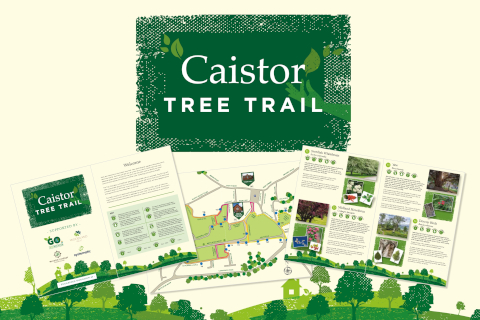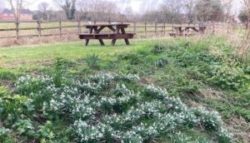Healing Moated Settlement Tree Trail
Welcome to our tree trail on Healing medieval moated site. We will introduce you to some of our trees and shrubs, with interesting facts about each one.
If you start the trail at the Westwood Road steps, and turn left at the bottom of the steps, you will meet the trees in order. Each tree has a notice attached to it, with its common name.
You can print off this trail or save it to a mobile device to take with you (instructions to follow).
The moated site is surrounded by a wonderful collection of trees. Trees are the superheroes of our green spaces. They provide shelter in winter and shade from the summer heat. Many birds use them as perches to see around their territory, or for nesting in. They capture carbon dioxide and create oxygen. They also filter out air pollution and provide a noise barrier. Their flowers provide nectar and pollen for insects and some of their fruits are eaten by a wide range of animals, including us. Lots of insects live in their bark and leaves. Over the centuries they have provided us humans with fuel for heating and cooking, and timber for buildings, boats, weapons and even games, such as cricket.
WARNING – take care where you are walking and please do not climb the trees. We advise you not to eat any part of the trees.
As you walk, have a think about how our medieval ancestors might have made use of trees on this very site. Some of the trees that you see will be descendants of those that the site dwellers knew well.
Oak.
The national tree of England, oaks can live for over 1000 years. Look out for flowers in spring – green are male and red female. The acorns form where the female flower sits on the branch. The leaves have lots of lobes on them. Oak trees support over 2000 different species, which use it for food and shelter. We only have two oak trees in this site, so they are precious to us.
Oak wood is very hard and was used for buildings and also for ships. The oak is a symbol of strength and for this reason oak trees have always been treated with respect.
Buddleia.
Buddleia is more of a shrub than a tree, it was brought to this country from China in Victorian times as a garden plant. Now, it has escaped and become settled in many places where little else will grow, such a waste ground and even out of the brickwork of buildings.
Buddleias have long narrow leaves and grows to about four metres (about 12 feet) high. Its purple flowers, with a honey-like fragrance, bloom from June to October and attract all kinds of butterflies and moths looking for nectar sources, so it is often known as the Butterfly Bush. Its winged seeds are dispersed by the wind and find it easy to colonise stony ground.
Ash.
This tree is very common in our village, and tends to grow quite large quickly, with its bark becoming deeply cracked as it ages. Some say its bark looks like an elephant’s skin. It can grow to 35 metres (over 110ft) in height. Its timber is extremely strong and is used for things like tool handles, boat oars and hockey sticks. The oval leaves form in pairs along thin stems, and in the winter you can see black buds waiting to open. It has tiny purple flowers in spring, before the leaves appear. In the autumn you can see the seed pods that hang in bunches, and are known as ‘keys’. It is also a distant relative of Olive trees.
The ash tree was believed to have mystical properties and also parts of it were used for medicines. Ash wood was burned to keep away bad spirits. The ash tree has strong associations with the Vikings, who called it the ‘world tree’, believing that its roots spread right down to the underworld. Ash logs burn very well and it was the wood chosen often for the Yule Log for winter festivals..
Hawthorn.
This small tree is also commonly seen as a hedge plant, due to its very prickly stems. It forms a dense thicket and helps to keep livestock in their fields. Hawthorn trees are extremely hardy and grow across Europe and eastwards as far as Afghanistan. Hawthorn trees and hedges were used in the past to show where a boundary of land ownership was, as they were such good survivors and formed important landscape features.
Hawthorn leaves are small and have little pieces cut out of them, leaving little lobes, so they look a bit like an animal paw print. When they first open they are reputed to taste like lettuce (please don’t eat the leaves), but our ancestors called them ‘bread and cheese’. The small white flowers usually open in May, and are called ‘May Blossom’. A Hawthorn tree is also sometimes called the May Tree, the only plant in England named after a month of the year. Red berries appear in the Autumn, each with a single seed inside.
Hawthorn trees are thought to be the preferred home of fairies, and in the past people didn’t like to cut them down, in case the fairies became cross at losing their place of rest. Their current ‘magic’ is to provide food and shelter for over 300 kinds of insects.
Blackthorn.
This tree only grows to about seven metres (just over 20 feet) and you will most often see it on our site as short single stems that have set themselves to form new bushes. It has a dark brown bark and straight branches with long spines. This is the ancestor of our edible plums. In spring the froth of small white flowers produces a spectacular display, before the little oval leaves appear, each with tiny teeth around the edge. In Autumn small black berries called ‘sloes’ appear. They are much loved by birds, and collected by some people to flavour gin.
The strong wood is said to have been used for magic wands and sorcerers’ staffs, though it is also good for ordinary walking sticks too.
Elder
This tree does not grow very tall, and often its branches grow completely straight upwards. The bark is like cork and has bumpy patches at its joints. You can see little holes called lenticels on the bark, which help the tree to take in air. The smell of crushed elder leaves is a natural fly repellent, so useful to have around if you have farm animals grazing nearby. In summer Elder produces a mass of white flowers that can be used to make a cordial, but if left they will develop into dark berries loved by birds.
People used to plant elder near their homes, as it is said to help keep bad spirits away.
Yew. WARNING all arts of this tree are poisonous to people and animals. DO NOT touch or eat.
These two small yew trees are evergreens, (they don’t lose their leaves in winter) so they provide a great place for birds to huddle into when the weather turns cold. The little soft spiny leaves are in two rows on each shoot, and when the trees get a bit older their bark will look very flaky. A Yew tree can live for thousands of years and is the longest lived of any British native tree. The tree seeds are held in little red fleshy cups in the autumn.
Yew trees are often found in churchyards, but no one really knows why. If a yew branch touches the ground then it can sprout and produce a new tree, so it may be that it is associated with the after-life.
Yew wood is very flexible and strong, and was used for making longbows.
Rose.
This is not a tree, but uses trees to climb up, and can form huge branches with a wide spread, so we have included it in our trail. This is commonly called the Dog Rose, and this specimen must be quite old, given the thickness of its branches. See the backward curving spines that hook onto trees and shrubs in order to climb. It is very difficult to untangle. Pale pink or white flowers produce rose ‘hips’, a shiny large red fruit. These are best left alone as they contain an irritant, though professionals use them to make a syrup that is high in Vitamin C.
The Dog Rose was thought to give protection from sorcerers, and is often seen in old paintings and carvings, with this meaning. Its roots were also supposed to help heal dog bites.
Ivy.
Ivy is not really a tree, but can develop into a large shrub. However, it is most often seen scrambling up other trees and shrubs. It has its own root system and clings onto any upright surface with small hairs like structures. It does not damage trees and may help older trees to remain upright for a long time.
Ivy is evergreen, young leaves have three or five lobes, and can be a mixture if different shades of green. Older branches carry oval glossy leaves – see if you can spot the two different leaf types. Older branches produce a magnificent display of flowers and berries in autumn. The flowers are a critical source of nectar and pollen for insects so late in the year. Try and see if you can smell their pleasant scent. The berries contain a lot of fat and so help many birds get through the winter.
Ivy was used by both the Greeks and the Romans to make into wreathes to give to people who won competitions, so it symbolises good achievements.
Willow.
Willow is found in wet places, and will happily grow with its roots in water. We have several magnificent willows in the ditch here, which must be many years old. Willow can grow very quickly from even the smallest pieces of the plant. You can see that our willows have fallen sideways and then grown upwards again, creating a wonderful tangle of branches that birds love to hide in.
There are several deferent types of Willow and we think that these are White Willow, the largest in the family. When the leaves are newly opened the undersides are covered in little white hairs. Look out for catkins early in the year.
Field Maple.
This medium sized tree has very narrow twigs and its leaves look like small hands. It has bunches of tiny green flowers in the spring, and its seeds are very much like those of a Sycamore (a close relation) but they have pink-tinged ends to them. Its leaves turn a buttery yellow in Autumn. The Maple is good at absorbing air pollution.
The ancient Greeks and Romans associated the Maple with romance, and the Maple tree was seen as a fitting wedding gift.
We hope you have enjoyed this trail, and that you might do it again at a different time of year so that you see the trees in different seasons. Any comments are welcome.

